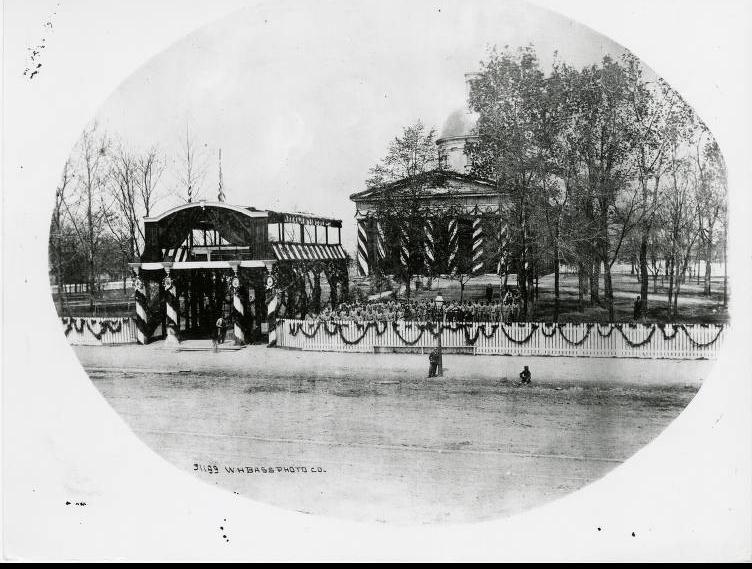The Lincoln funeral train arrived in a rainy Indianapolis at 7 A.M. on Sunday, April 30, 1865. The coffin was transferred to a hearse drawn by four white horses, and a procession led by Governor and Maj. Gen. Joseph Hooker formed to accompany the remains to the . A long procession through the city was canceled due to the weather.

Soldiers from Indianapolis camps lined both sides of the procession’s route. Upon arrival at the Capitol, the coffin was placed on an elaborate dais in the rotunda and the upper third of the lid was opened so that mourners might see the face of the president.
The public viewing began at 8 A.M. and continued until 10 that night. There is no accurate figure for the number of people paying their respects in the rotunda, but both the and estimated the crowd at “not less than 50,000″—slightly more than the entire city population five years later.
Between 10 and 11 P.M. the guard of honor returned the coffin to the hearse, and a procession accompanied the coffin to the waiting train. The reported: “This was the most solemn and imposing of all the pageantry that has attended the remains in this city. The wailing sadness of the music, the fitful glare of the lamps, the deep silence unbroken except by the heavy tramp of the soldiers and muffled rumbling of carriage wheels, made it the most impressive scene of all, in the mournful occasion.”
FURTHER READING
- Cottman, George S. “Lincoln in Indianapolis.” Indiana Magazine of History, March 1928. https://scholarworks.iu.edu/journals/index.php/imh/article/view/6446/6614.
CITE THIS ENTRY
APA:
Darbee, L. (2021). Abraham Lincoln’s Funeral Cortege. Encyclopedia of Indianapolis. Retrieved Jan 6, 2026, from https://indyencyclopedia.org/abraham-lincoln-s-funeral-cortege/.
MLA:
Darbee, Leigh. “Abraham Lincoln’s Funeral Cortege.” Encyclopedia of Indianapolis, 2021, https://indyencyclopedia.org/abraham-lincoln-s-funeral-cortege/. Accessed 6 Jan 2026.
Chicago:
Darbee, Leigh. “Abraham Lincoln’s Funeral Cortege.” Encyclopedia of Indianapolis, 2021. Accessed Jan 6, 2026. https://indyencyclopedia.org/abraham-lincoln-s-funeral-cortege/.

Help improve this entry
Contribute information, offer corrections, suggest images.
You can also recommend new entries related to this topic.